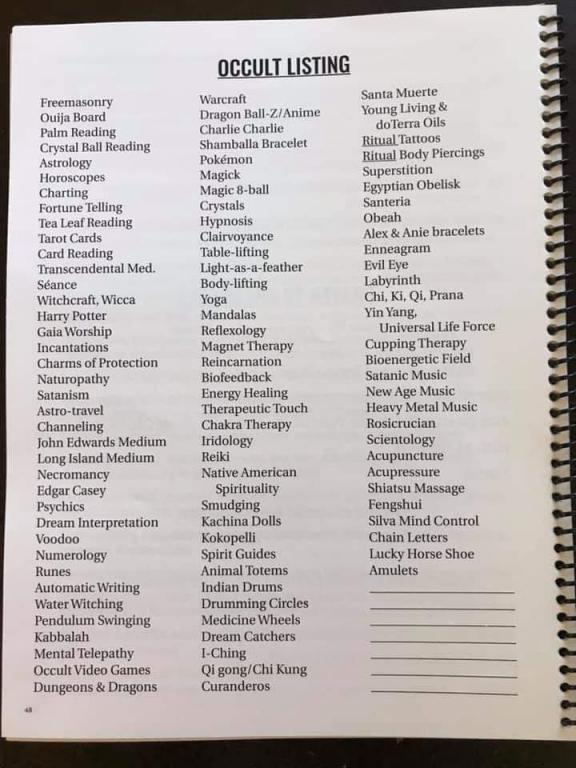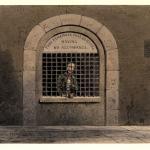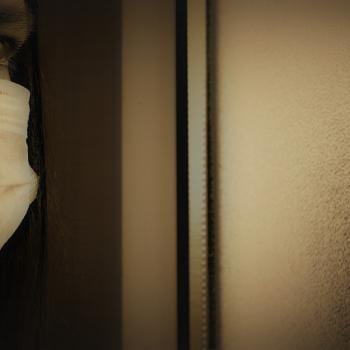A group called Missionaries of the New Evangelization has circulated a list of “occult” practices that could lead to demonic influence. The list includes everything from freemasonry to tea leaves, dream interpretation to tarot. Some of the items on the list are the usual suspects: Harry Potter, yoga, heavy metal, and Dungeons and Dragons. Some items are simply silly, such as Pokemon.
Perhaps some of the listings could be regarded as questionable given the way historically hermetic or esoteric practices have been associated with methodologies of control, manipulation, cult behavior, violence, and even fascism. My own experience with Christian cult thinking has made me wary of many ritual practices that are intended to grant power or manipulate events, as well as with signs and wonders, or secret teachings.
Just because a practice is not per se demonic doesn’t mean it is wholesome or without the possibility of abuse. For a good humanist study on how hermetic practice can be dangerous, I refer you to Umberto Eco’s magnificent novel Foucault’s Pendulum.
Racist prejudice
My issue with lists like this is not that everything on it is in fact benevolent or harmless or just silly. It’s that there is invariably a racist dimension to the fear of “demonic influence” given that a disproportionate number of practices listed are specifically non-white, non-western, non-European.
Because many items on the demon-list are not arcane practices in the bizarre backwaters of religious decadence, not part of niche cults, but are actual central or mainstream religious traditions of cultures not our own. I’ve long noticed this with the fear of spiritual practices connected with yoga. Why should the religion of Eastern peoples be so especially dangerous? Why would it be automatically more fearsome than invoking the muse or goddess at the beginning of a Homeric epic, or depicting Christ as Apollo in Renaissance art? The main trend seems to be a racist reaction to the otherness, the non-whiteness, or eastern traditions,
And this particular list includes not only yoga, but also Native American spirituality, drumming circles, I-Ching, mediine wheels, mandalas, Yin-Yang, Fengshui, Chakra therapy, and even – to add a touch of anti-semitism – Kabbalah. As my friend and fellow Patheos columnist Mindy Selmys stated, “this isn’t about protecting yourself from demonic influences, it’s about maintaining a worldview that is Eurocentric while demonizing other cultures.”
And this is especially shameful considering how often Christian settlers in the Americas used their religion as an excuse to harm and persecute native peoples. Given our shameful colonial tradition and how implicated our religion is in acts of violent genocide, we should not be demonizing non-white American religious traditions today.
In general, a lot of what looks occult and freaky to an outsider is often simply religious ritual, a fundamentally sacramental approach to nature according to which certain physical actions and objects can be viewed as connecting us with the transcendent. Catholics do it all the time. Are our practices superstitious? Maybe. Burying a St. Joseph statue on property you hope to buy looks not only like superstition, but like spell-casting.
Christianity and Magic
And this brings up the – perhaps, to some, uncomfortable – reality that in our Christian tradition at times our practices have overlapped significantly with rituals that might today be considered occult or witchcraft. This is still true today with devotions like asking St. Therese to send a rose. And it was very true in the past, before the different disciplines became separated. The teacher of St. Thomas Aquinas, Albert the Great, is renowned not only in Catholic circles as a saint and doctor of the church, but is regarded by disciples of the arcane as a master. Yes, most of the works on magic attributed to him were not his own, but his actual writings do make evident his belief in alchemy and astrology. Similarly, much that was taught by St. Hildegard of Bingen and St. Brigid would also be regarded as “witchcraft” by the perpetually afraid, today.
Now, my point is not that all religious practices are harmless. Some are, I believe, intrinsically evil: human sacrifice, for instance. Or forced conversion on pain of death. Others are perhaps neutral, with a capacity to be either beneficial or harmful, depending on how they are used.
But it’s important to educate oneself in the history of world religions before making kneejerk responses that are born largely out of a racist and xenophobic fear of the other.
Religion can be harmful.
Perhaps all religions contain within them the capacity to become dangerous, violent, and therefore evil. And not just those freaky other religions not our own. When I look at what is happening within my own church, I see influences that could very well be called “demonic.” Religion is a powerful force, and as such it can give great comfort and bring people together in unity and healing – or, conversely, do terrible damage.
The fact that human sacrifice has been practiced by so many different religions – including the revered ancient Greek religion(s) – should remind us to be wary. Violence is often linked with the sacred, as Rene Girard has explored – and whether one agrees or disagrees with his assessments, history makes the point clear.
So yes, I do think we should ask whether a particular religious practice inclines towards the evil, the destructive, the abusive – call it the “demonic” if you like. And yes, I think we should be aware of the way this can happen even within Christianity. It has happened before, with our holy wars and inquisitions. With our persecutions. And it is happening again, before our eyes, as our religious leaders use their power not to heal victims but to protect abusers.
image from facebook













